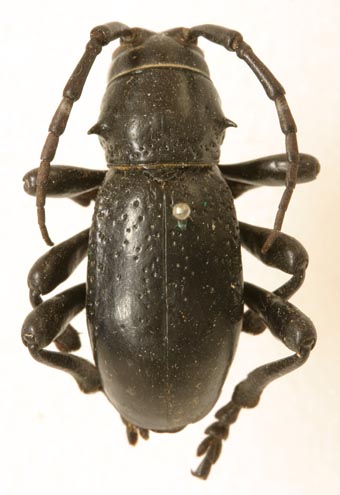 |
Moneilemini
Classification
Introduction
- The tribe Moneilemini Thomson, 1864 currently contains 21 species in 1 genus. Photographs of 1 exemplar specimen are currently available for this tribe.
Diagnostic Features of Adults
- Body moderate-sized, approximately 10-40 mm, rarely less than 10 mm in length; generally ovoid; body without metallic reflection. Eyes generally reniform, complete (not completely divided into upper and lower lobes). Antennae filiform, unarmed; antennae short, not extending beyond elytral apices. Head without distinct lateral or anterior projections. Pronotum approximately subquadrate (about as long as wide); lateral margins of pronotum with distinct spines or blunt tubercles. Mesocoxal cavity closed to mesepimeron. Wings generally absent or reduced. Legs with tarsal claws smooth; claws broadly divergent (divaricate).
Diagnostic Features of Larvae
- Larva. Cylindrical, robust, coarsely haired species; head depressed, sides parallel, broadly rounded posteriorly; clypeus and labrum thick, latter about twice as wide as long; mandible scarcely tapering, about twice as wide as basal width, cutting edge short, roundly emarginate, outline similar to Michthisoma; antennal ring entire. Ventral mouth-parts fleshy; mentum distinct from submentum, narrowly transverse, not sunken; chitinization entire across base of labial stipes; last joint of maxillary palpi minute, scarcely one-half the length of second. Posterior area of pronotum narrowly transverse, four times as wide as deep, limited anteriorly by a short impression at each side, often bearing numerous short hairs; dorsal abdominal ampullae irregularly tuberculate or covered with conical papillae, strongly projecting and deeply bilobed, having a single transverse impression, epipleurum protuberant on all segments, tubercle broadly oval, bearing many setae but lacking the chitinous pore at each extremity; spiracles orbicular, peritreme distinct; no caudal armature. Adapted from Craighead (1923).
Geographic Distribution of Tribe
Biology and Economic Importance
- Biology from Linsley & Chemsak coming soon. Species of this tribe are potentially invasive outside their native range.
Selected References to Adult Specimens
Selected References to Larvae Specimens
|  |

Moneilema gigas
LeConte, 1873; dorsal
holotype specimen
Cerambycidae:Lamiinae:Moneilemini
Photograph © E.H. Nearns
|




